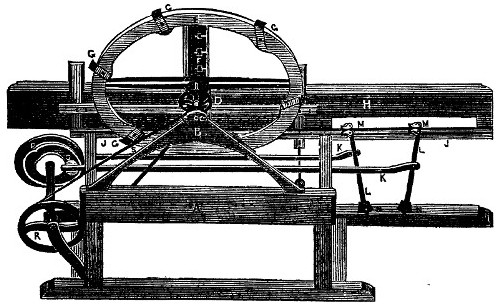In 1849 this maker was touting the "Improved Barnum planing machine". The improvements were patented and assigned to Mr. Daniel Barnum. Barnum installed one of his machines in a sawmill, and was promptly sued by the owners of the Woodworth planing machine patent. After a protracted court battle, Barnum prevailed, and, after marketing his machine for a year or so, sold his patent to the holders of the Woodworth patent (Jason G. Wilson, Edward Bloomer, and William W. Woodworth Jr.) who buried Barnum's planer.

From an article in the January 20, 1849 issue of Scientific American
Information Sources
- See the datamp.org entry for the Barnum planer patent for more information.
- From the 1849-06-09 issue of Scientific American comes this news item.
Very Important Patent Cases, On Friday the 1st inst. in the United States Circuit Court, Philadelphia in Equity, before Judges Grier and Kane, the important patent case of Woodworth's and Barnum's Planing Machines, Wilson vs. Barnum, was decided, and the opinion of the Court given by Judge Kane, and an interlocutory injunction granted, according to the prayer of the bill until hearing by a further order of the Court. We make no comments on the above, only we should like to have heard the curious opinion of the Court. An engraving and description of Barnum's machine will be found in No. 18, this vol Scientific American. It may explain something about this decision when we say the able Hon. W. H. Seward was Mr. Wilson's counsel in the case.
- From the 1850-12-28 Scientific American:
Barnum's Planing Machine. On our advertising page there is offered for sale the Patent Planing Machine of Mr. Daniel Barnum, of Philadelphia. We request the especial attention of all those who are engaged in the business of planing lumber, to that advertisement. An engraving of this machine was published in No. 18, Vol. 4, Scientific American. It was patented after that, and has been the subject of litigation in Philadelphia; Judge Kane granted an injunction, and it was raised afterwards and brought to a jury trial, when it was left undecided—eleven of the jury being in favor of this machine, as being no infringement of Woodworth's, and one against. We have never seen it in operation, but disinterested persons who have seen it, have spoken to us of its good qualities, stating that it produced the best work of any machine they ever saw in operation.